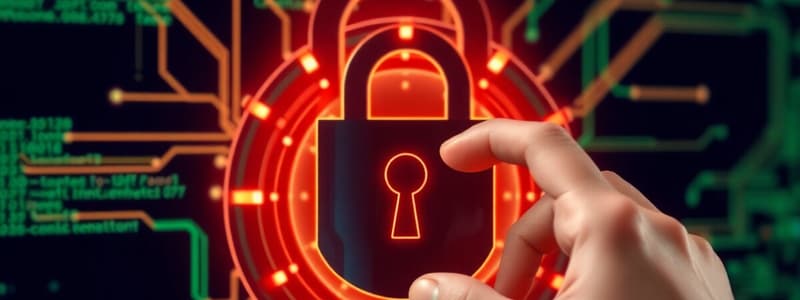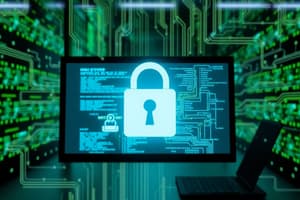Podcast
Questions and Answers
What was a primary focus of computer security efforts immediately following the development of the first mainframes?
What was a primary focus of computer security efforts immediately following the development of the first mainframes?
- Implementing encryption for online transactions
- Securing physical access to sensitive military locations (correct)
- Developing antivirus software for personal computers
- Preventing unauthorized access to social media accounts
In the early stages of the Internet, security was given high priority in deployments
In the early stages of the Internet, security was given high priority in deployments
False (B)
What is the primary goal of information security?
What is the primary goal of information security?
To be free from danger
The C.I.A. triangle is based on confidentiality, integrity, and ______.
The C.I.A. triangle is based on confidentiality, integrity, and ______.
Match the following security layers with their descriptions:
Match the following security layers with their descriptions:
Which of the following is the BEST description of an 'asset' in information security terminology?
Which of the following is the BEST description of an 'asset' in information security terminology?
Risk can ever be entirely eliminated.
Risk can ever be entirely eliminated.
What is the role of the Data Custodian?
What is the role of the Data Custodian?
A ______ is someone who promotes a project and ensures its support, both financially and administratively
A ______ is someone who promotes a project and ensures its support, both financially and administratively
Match the characteristic to its description
Match the characteristic to its description
According to the information presented, what is most accurate about security?
According to the information presented, what is most accurate about security?
Implementation of information security is purely a science.
Implementation of information security is purely a science.
Name any 3 components of Information Systems.
Name any 3 components of Information Systems.
The threat agent is a ______ that has the power to carry out the threat.
The threat agent is a ______ that has the power to carry out the threat.
Match the following descriptions with the correct role.
Match the following descriptions with the correct role.
Which of the following BEST describes the principle of 'Defense in Depth'?
Which of the following BEST describes the principle of 'Defense in Depth'?
The Chief Information Officer usually reports directly to the Chief Information Security Officer.
The Chief Information Officer usually reports directly to the Chief Information Security Officer.
What is the job of a penetration tester?
What is the job of a penetration tester?
The principle of least privilege involves giving users the ______ level of access necessary to perform their duties.
The principle of least privilege involves giving users the ______ level of access necessary to perform their duties.
Match the following security terms with their corresponding descriptions:
Match the following security terms with their corresponding descriptions:
Bisbey and Hollingworth wrote a report on the vulnerabilities of operating systems, what project was this for?
Bisbey and Hollingworth wrote a report on the vulnerabilities of operating systems, what project was this for?
It is possible to achieve perfect information security.
It is possible to achieve perfect information security.
Who should security administrators interact with, to reduce the risk caused by end-users?
Who should security administrators interact with, to reduce the risk caused by end-users?
According to Reeds and Weinberger, 'No ______ can be secure against wiretapping or its equivalent on the computer.
According to Reeds and Weinberger, 'No ______ can be secure against wiretapping or its equivalent on the computer.
Select all items that are reasons why information security is essential:
Select all items that are reasons why information security is essential:
What made computer security more important starting in the 2000s?
What made computer security more important starting in the 2000s?
Cybersecurity is a subset of Information Security.
Cybersecurity is a subset of Information Security.
According to the OSI Model, what is a security attack?
According to the OSI Model, what is a security attack?
In Information Security Terminology, is a weakness that allows a threat agent to bypass security.
In Information Security Terminology, is a weakness that allows a threat agent to bypass security.
Match the following roles in an information security team to their descriptions:
Match the following roles in an information security team to their descriptions:
What is 'Separation of Duties' and why is an important security principle?
What is 'Separation of Duties' and why is an important security principle?
A 'Threat' is a weakness in a system that makes it vulnerable to attack.
A 'Threat' is a weakness in a system that makes it vulnerable to attack.
According to the OSI model, what is a Security Mechanism?
According to the OSI model, what is a Security Mechanism?
In computer security, controls are to intended to limit acces to sensitive military locations to authorized personnel.
In computer security, controls are to intended to limit acces to sensitive military locations to authorized personnel.
Match the Security Professionals to their descriptions:
Match the Security Professionals to their descriptions:
According to Dennis Ritchie what is important in computer security?
According to Dennis Ritchie what is important in computer security?
The Chief Information Security Officer is primarily responsible for strategic planning.
The Chief Information Security Officer is primarily responsible for strategic planning.
In the OSI model, the services intended to counter security what is the correct term?
In the OSI model, the services intended to counter security what is the correct term?
The internet brings millions of computer networks into ______ that are often unsecured.
The internet brings millions of computer networks into ______ that are often unsecured.
What are the 3 aspects of information security according to the OSI model?
What are the 3 aspects of information security according to the OSI model?
Flashcards
Physical Controls
Physical Controls
Limiting access to military locations to authorized personnel only.
Security
Security
The quality of being secure from danger
Information Security
Information Security
Guards data during use, storage, and transmission
Types of Security
Types of Security
Signup and view all the flashcards
Necessary Security Tools
Necessary Security Tools
Signup and view all the flashcards
C.I.A. Triangle
C.I.A. Triangle
Signup and view all the flashcards
Subject of an Attack
Subject of an Attack
Signup and view all the flashcards
Object of an Attack
Object of an Attack
Signup and view all the flashcards
Critical Info Characteristics
Critical Info Characteristics
Signup and view all the flashcards
Information System (IS)
Information System (IS)
Signup and view all the flashcards
Importance of Info Security
Importance of Info Security
Signup and view all the flashcards
Data Protection
Data Protection
Signup and view all the flashcards
Security Champion
Security Champion
Signup and view all the flashcards
Data Owner
Data Owner
Signup and view all the flashcards
Data Custodian
Data Custodian
Signup and view all the flashcards
Data Users
Data Users
Signup and view all the flashcards
What is Info Security?
What is Info Security?
Signup and view all the flashcards
Security Defined
Security Defined
Signup and view all the flashcards
Comprehensive Info Security
Comprehensive Info Security
Signup and view all the flashcards
Asset
Asset
Signup and view all the flashcards
Threat
Threat
Signup and view all the flashcards
Threat Agent
Threat Agent
Signup and view all the flashcards
Vulnerability
Vulnerability
Signup and view all the flashcards
Risk
Risk
Signup and view all the flashcards
Information Security (InfoSec)
Information Security (InfoSec)
Signup and view all the flashcards
Cybersecurity
Cybersecurity
Signup and view all the flashcards
Security Attack
Security Attack
Signup and view all the flashcards
Security Mechanism
Security Mechanism
Signup and view all the flashcards
Security Service
Security Service
Signup and view all the flashcards
Least Privilege
Least Privilege
Signup and view all the flashcards
Separation of Duties
Separation of Duties
Signup and view all the flashcards
Defense in Depth
Defense in Depth
Signup and view all the flashcards
Zero Trust
Zero Trust
Signup and view all the flashcards
Security by Design
Security by Design
Signup and view all the flashcards
Study Notes
- Introduction to Information Security Management - Part 1
History of Information Security
- Computer security started immediately after the development of the first mainframes.
- Multiple levels of security were implemented on mainframes.
- Physical controls limited access to sensitive military locations to authorized personnel.
- Rudimentary measures defended against physical theft, espionage, and sabotage.
Key Dates in Early Computer Security
- 1968: Maurice Wilkes discussed password security in Time-Sharing Computer Systems.
- 1973: Schell, Downey, and Popek examined the need for additional security in military systems in "Preliminary Notes on the Design of Secure Military Computer Systems."
- 1975: The Federal Information Processing Standards (FIPS) examined Digital Encryption Standard (DES) in the Federal Register.
- 1978: Bisbey and Hollingworth published "Protection Analysis: Final Report", discussing the Protection Analysis project created by ARPA to better understand operating system security vulnerabilities and explore automated vulnerability detection techniques.
- 1979: Morris and Thompson authored "Password Security: A Case History", examining the history of password security design for remote access systems.
- 1979: Dennis Ritchie published "On the Security of UNIX" and "Protection of Data File Contents", discussing secure user IDs, group IDs, and their related problems.
- 1984: Grampp and Morris wrote "UNIX Operating System Security", examining physical control of premises, management commitment, employee education, and administrative procedures concerning security.
- 1984: Reeds and Weinberger published "File Security and the UNIX System Crypt Command", emphasizing that no technique is secure against wiretapping or privileged users.
The 1990s
- Networks of computers became more common, increasing the need to interconnect them.
- The Internet was the first manifestation of a global network of networks.
- Initial Internet infrastructure relied on de facto standards.
- Security was a low priority in early Internet deployments.
2000 to Present
- The Internet connected millions of computer networks, many of which were unsecured.
- The security of a computer’s data is influenced by the security of every connected computer.
- The growing threat of cyber attacks has increased the need for improved security.
What is Security?
- Security is "The quality or state of being secure to be free from danger".
- A successful organization should have multiple layers of security.
- These include physical, personal, operations, communications, network, and information security.
- Security includes the protection of information and its critical elements like systems and hardware.
- Essential tools include policy, awareness, training, education, and technology.
- The C.I.A. triangle focuses on confidentiality, integrity, and availability.
- The C.I.A. triangle has now expanded into list of critical characteristics of information.
Key Information Security Concepts
- A computer can be the subject of an attack, the object of an attack, or both.
- When it is the subject, the computer is used as an active tool to conduct the attack.
- When it is the object, the computer is the target being attacked.
Critical Characteristics of Information
- Availability: Information is accessible when needed.
- Accuracy: Information is correct and without error.
- Authenticity: Information is genuine and verifiable.
- Confidentiality: Information is protected from unauthorized access.
- Integrity: Information is complete and uncorrupted.
- Utility: Information is useful and serves a purpose.
Components of an Information System (IS)
- An information system is the set of components necessary to use information as a resource.
- These components include software, hardware, data, people, procedures, and networks.
Balancing Information Security and Access
- Achieving perfect security is impossible, it is a process.
- Security should balance protection and availability.
- The level of security should allow reasonable access while protecting against threats.
Why is Information Security Important?
- Data protection is about safeguarding personal, financial, and confidential business information.
- It maintains business continuity protecting businesses from attacks that disrupt operations.
- It is also about preventing financial loss, as cyber attacks can result in significant losses.
- It preserves business reputation, because a cyber attack can damage an organization’s reputation.
- Legal requirements dictate that many industries are regulated and need to meeet cybersecurity standards.
Security Professionals and the Organization
- A wide range of professionals support a diverse information security program.
- Senior management plays a key role in information security.
- Additional administrative support and technical expertise are required.
Senior Management Roles
- Chief Information Officer (CIO) is the senior technology officer.
- CIOs advise senior executives on strategic planning.
- Chief Information Security Officer (CISO) is responsible for assessment, management, and implementation of information security (IS).
- CISOs usually report directly to the CIO.
Information Security Project Team
- This is a group of individuals experienced in technical and non-technical aspects.
- The Champion is a senior executive who promotes and supports the project financially and administratively.
- Security policy developers understand the organizations culture, policies, and requirements needed to develop and implement successful policies.
- Risk assessment specialists understand financial risk techniques, the worth of organizational assets, and the security methods to be used.
Data Responsibilities
- The Data owner is responsible for the security and use of a particular set of information.
- The Data custodian is responsible for storage, maintenance, and protection of information.
- Data users are end users who leverage the information to perform their daily tasks.
Communities of Interest
- Are groups of individuals united by similar interests/values within an organization.
- These include information security management and professionals, IT management and professionals and organizational management and professionals.
Information Security: Art or Science?
- Implementing information security is a combination of art and science.
- The "Security artesian" idea is based on the way people perceive systems technologists.
Security as Art
- Security has no hard and fast rules, nor universally accepted solutions.
- There is no one manual for implementing security across an entire system.
Security as Science
- Security involves dealing with technology designed to operate at high-performance levels.
- Specific conditions cause virtually all actions in computer systems.
- Nearly every fault, security hole, and system malfunction results from interaction of specific hardware and software.
- With sufficient time, developers could resolve and eliminate faults.
Security as a Social Science
- Social science examines the behavior of individuals interacting with systems.
- Security begins and ends with the people that interact with the system.
- Security administrators can greatly reduce levels of risk by understanding behaviors of end users and build better security postures.
Defining Information Security
- Security is the state of freedom from danger or risk, achieved through protective measures.
- Information security is the task of safeguarding of digital information.
- Information security ensures protective measures are correctly implemented.
- Information security cannot completely prevent attacks or guarantee a totally secure system.
Defining Information Security (Continued)
- Information security is to protect information that is of value to people and organizations.
- This value comes from confidentiality, integrity, and availability.
- Information security is achieved through a combination of people, products and procedures.
Information Security Terminology
- Asset: Something that has a value.
- Threat: An event or object that may defeat the security measures in place and result in a loss.
- Threat agent: A person or thing that has a power to carry out a threat
- Vulnerability: Is a weakness that allows a threat agent to bypass security.
- Risk: The likelihood that a threat agent will exploit a vulnerability.
- Realistically, risk cannot ever be entirely eliminated.
Information Security (InfoSec)
- InfoSec focuses on protecting all types of information, digital, physical, or intellectual, from unauthorized access, misuse, destruction, or alteration.
- The goal is to preserve confidentiality, integrity, and availability (CIA) of information.
- InfoSec includes both physical security (server rooms, locking file cabinets) and technical security (encryption, access controls).
Cyber Security
- Cybersecurity is a subset of information security that focuses on protecting digital systems and data from cyberattacks.
- It secures computers, networks, servers, and data from breaches, hacks, or malicious attacks.
OSI Security Architecture
- Aspects of information security include security attack, security mechanism, and security service.
- Security attack is any action that compromises the security of an organizations information.
- Security mechanism is a process or device to detect, prevent, or recover from a security attack.
- Security service is a processing or communication service that enhances system security and information transfers.
- The services are for countering security attacks, and use one or more security mechanisms.
Information Security Careers
- Careers in information security support business operations by covering security administrators, access coordinators, security architects, security consultants and security testers.
Key Roles in Information Security
- Security Analyst: Monitors and investigates security incidents and threats.
- Security Engineer: Designs and implements security solutions.
- Penetration Tester (Ethical Hacker): Simulates attacks to find weaknesses before malicious actors do.
- Chief Information Security Officer (CISO): Oversees an organization’s entire cybersecurity strategy.
- Incident Responder: Responds to cybersecurity incidents and works to contain and mitigate damage.
Information Security Principles
- Least Privilege: Users should have only the necessary access to perform duties.
- Separation of Duties: Dividing tasks so no individual controls all aspects of a critical function.
- Defense in Depth: Using multiple security controls to protect against threats.
- Zero Trust: No one should be trusted by default, whether inside or outside the network.
- Security by Design: Incorporating security measures into systems from the ground up.
Studying That Suits You
Use AI to generate personalized quizzes and flashcards to suit your learning preferences.




